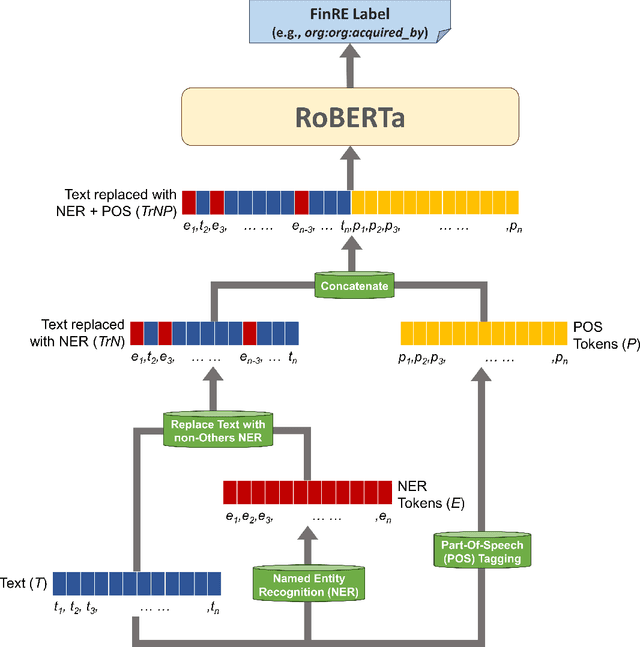Menglin Li
Enhancing Language Models for Financial Relation Extraction with Named Entities and Part-of-Speech
May 02, 2024

Abstract:The Financial Relation Extraction (FinRE) task involves identifying the entities and their relation, given a piece of financial statement/text. To solve this FinRE problem, we propose a simple but effective strategy that improves the performance of pre-trained language models by augmenting them with Named Entity Recognition (NER) and Part-Of-Speech (POS), as well as different approaches to combine these information. Experiments on a financial relations dataset show promising results and highlights the benefits of incorporating NER and POS in existing models. Our dataset and codes are available at https://github.com/kwanhui/FinRelExtract.
Optimizing Group Utility in Itinerary Planning: A Strategic and Crowd-Aware Approach
Apr 20, 2023Abstract:Itinerary recommendation is a complex sequence prediction problem with numerous real-world applications. This task becomes even more challenging when considering the optimization of multiple user queuing times and crowd levels, as well as numerous involved parameters, such as attraction popularity, queuing time, walking time, and operating hours. Existing solutions typically focus on single-person perspectives and fail to address real-world issues resulting from natural crowd behavior, like the Selfish Routing problem. In this paper, we introduce the Strategic and Crowd-Aware Itinerary Recommendation (SCAIR) algorithm, which optimizes group utility in real-world settings. We model the route recommendation strategy as a Markov Decision Process and propose a State Encoding mechanism that enables real-time planning and allocation in linear time. We evaluate our algorithm against various competitive and realistic baselines using a theme park dataset, demonstrating that SCAIR outperforms these baselines in addressing the Selfish Routing problem across four theme parks.
A Transformer-based Framework for POI-level Social Post Geolocation
Oct 26, 2022Abstract:POI-level geo-information of social posts is critical to many location-based applications and services. However, the multi-modality, complexity and diverse nature of social media data and their platforms limit the performance of inferring such fine-grained locations and their subsequent applications. To address this issue, we present a transformer-based general framework, which builds upon pre-trained language models and considers non-textual data, for social post geolocation at the POI level. To this end, inputs are categorized to handle different social data, and an optimal combination strategy is provided for feature representations. Moreover, a uniform representation of hierarchy is proposed to learn temporal information, and a concatenated version of encodings is employed to capture feature-wise positions better. Experimental results on various social datasets demonstrate that three variants of our proposed framework outperform multiple state-of-art baselines by a large margin in terms of accuracy and distance error metrics.
 Add to Chrome
Add to Chrome Add to Firefox
Add to Firefox Add to Edge
Add to Edge